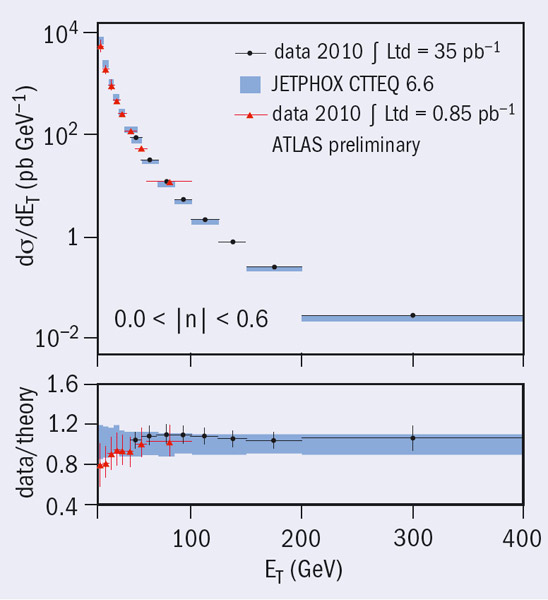
Photons have an important role at the LHC, not only as tools for testing the Standard Model but also as heralds of new physics. The ATLAS collaboration has recently announced two measurements that in one case make use of photons as probes of QCD and in a second analysis use them to set limits on the production of the Higgs boson.
The production mechanism of photons in proton–proton collisions is sensitive to the density of the basic constituents within the colliding particles. This makes the measurement of their properties an excellent way to test the theoretical predictions of perturbative QCD, with a technique that is complementary to studies based on jets. One example is the new measurement made by the ATLAS collaboration of the inclusive production of isolated prompt photons.
The analysis uses the full 2010 data sample collected by ATLAS in LHC proton–proton collisions at 7 TeV, corresponding to an integrated luminosity of 35 pb–1. The result extends the measurement of the cross-section up to a photon transverse momentum of 400 GeV (figure 1), thus covering a kinematic region similar to that achieved at Femilab’s Tevatron and by the CMS collaboration at the LHC. QCD calculations performed at next-to-leading order (NLO) predict cross-sections that are in good agreement with the measured data across five orders of magnitude. Below 25 GeV, where the NLO predictions are less accurate, the predicted cross-section is larger than that measured in the data.
Photons are also important signatures of new physics, a familiar example being the production of a Standard Model Higgs boson decaying into a photon pair. If nature has chosen the Standard Model Higgs as the mechanism for electroweak-symmetry breaking, then about 10,000 Higgs bosons should already have been produced in ATLAS, assuming a light mass for the Higgs of about 120 GeV/c2. In this mass region, the decay into two photons remains the most promising channel for discovery, despite the small branching ratio of about 0.2%.

Using an integrated luminosity of 209 pb–1 from the full 2010 data sample, and the first part of the data collected in 2011, the ATLAS collaboration has studied the di-photon invariant mass spectrum in the mass range 100–150 GeV/c2 and looked for a possible excess of events that could be attributed to the decay of a new neutral particle. In this analysis, the different components associated to known processes were separated using the same data-driven technique as was used to measure the inclusive photon production cross-sections. The fluctuations observed in the di-photon invariant mass spectrum are compatible with the expected statistical fluctuations of the background. This translates into limits on the production cross-section of a Standard Model-like Higgs boson decaying into a pair of photons that range between 4 and 16 times the cross-section expected.
With the LHC delivering increasing amounts of data, both measurements are already set to improve.
Further reading
ATLAS collaboration 2011 Phys. Rev. D 83 052005.
ATLAS collaboration 2011 ATLAS-CONF-2011 -058.
CMS collaboration, https://twiki.cern.ch/twiki/bin/view/ CMSPublic/PhysicsResultsQCD10037.
ATLAS collaboration 2011 ATLAS-CONF-2011 -085.








